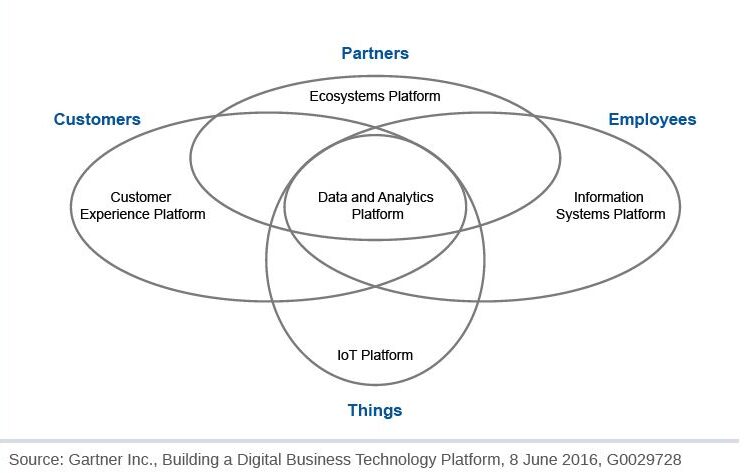Organizations need to transition towards a digital business ecosystem that uses data and analytics as a tactical weapon. This requires significant adaption in organizational culture, one that is driven by a data strategy and supported by a robust Business Process Management (BPM) based analytics platform.
Why Analytics?
2.5 quintillion data bytes are generated per day, up from 100 GB in 1992. That’s a torrent of information created by the combined forces of social, mobile and cloud technologies. Not only do most organizations struggle to deal with this data but also fail to realize the opportunities which can be realized by leveraging this data. Imagine the competitive advantage that your organization would have if you could harness this information.
Analytics can help organizations make effective use of this information by bringing in new capabilities and transform existing capabilities of an enterprise. Organizations can digitally transform themselves by combining analytical capabilities with Business Process Management (BPM), Enterprise Content Management (ECM), Case Management and Customer Communication Management (CCM) capabilities.
Analytics can help organizations:
- Figure out the What, Why and How of cases and events
- Make processes smarter
- Empower knowledge workers
- Uncover opportunities and capitalize on it
Analytics – The catalyst to the shift in Organizational Focus
The focus on efficiency
Efficiency has been and will continue to be a mantra for organizations. Lower cost and reduced process cycle time are the drivers of efficiency. Process Analytics capabilities within business process management such as descriptive analytics enable organizations to see what is happening in real time and provides operational managers with the ability to get right information for taking corrective steps.
Gartner Predictions
Source: Gartner Inc., 100 Data and Analytics Predictions Through 2020. 24 March 2016, G00301430 |
This is a great first step to monitor and streamline operations when necessary. Managers can leverage on capabilities such as creating dashboards to visualize operations and set alerts for events such as SLA breach.
However, at times, organizations need to get more information from data. For instance the reasons for SLA breach. Were the resources allocated to a process or a task of a process performing optimally? Was there a substantial increase in workload which caused the breach? What was the cause of the increase in workload? Did multiple factors cause the SLA breach?
Diagnostic Analytics capabilities facilitate such fact finding. It goes a long way to enable organizations to take informed decisions. Organizations use BPM software capabilities such as suggestions and drill down capabilities to discover causes. This composite view through the system enables organizations to see the big picture, and the drill down abilities provide the necessary analytical ability to take pin-pointed actions.
The shift in focus to growth & customer experience
Many organization have recognized that the focus on cost and efficiency alone will not be sufficient. Innovation driven growth and customer experience are key imperatives of organizations. Organizations need the ability to go beyond improvement to “Improvization”. The combination of case management and analytics are enablers to achieve this.
Case Management enables organizations to handle dynamic situations and adapt based on the needs of the customer.
Employees need to become knowledge workers for organizations to be customer centric. Analytics enabled BPM software confers a number of capabilities to knowledge workers. Content from ECM repositories can be made available to knowledge workers through a combination of Virtual Repository Management, Insight Engines, and Content Analytics.
Information and content in the context of the task being performed empowers knowledge workers to take informed decisions.
Suggestive analytics capabilities of the system guides the action of knowledge workers by providing them information regarding actions taken in the past for similar scenarios.
This enables knowledge workers to draw on and build on the composite knowledge of the organization. The system leverages on cognitive capabilities to suggest possible next actions to knowledge workers and further enhance their productivity by setting up the subsequent tasks.
Organizations can leverage on process discovery capabilities of the system to understand the process paths. Process heat maps enable organization to gain insights regarding frequently traversed paths and bottlenecks in the path. The system goes a step further and suggests modifications to the process and optimal resource allocations to achieve organization goals.
Become future-ready with Advanced Analytics
Till now we have seen analytics guiding us on the what/why of current happenings. This enables organizations to take appropriate corrective actions. But organizations also need the ability to predict what is likely to happen in the future.
Analytics enabled BPM solution has the capability to find and highlight exceptions which will impact a future transaction. For instance, the system can forewarn process owners about information / documents which may be needed to complete the transaction. The system leverages on past patterns and learns from these patterns to predict both the path of the transaction and the likely time of completion of the transaction. This information enables process owners to create new tasks in parallel to sourcing information which will be required in the future. The system also informs stakeholders of the likely time of completion of the transaction enabling stakeholder to plan out further activities.
Decision Making Support and Autonomous Decision Making
Analytics enabled BPM solution also comes with decision support capabilities. For instance the system allows organizations to specify goals and constraints and suggests appropriate resources and paths based on the same. The system may allow organizations to simulate and visualize the impact of the decision to enable organizations to take the right decisions.
In the near future, process owners may increasingly rely on the knowledge and learning of the system and allow the system to autonomously make decisions and convert processes into straight through processes.
Finer Analytical nuances: Process driven analytics vs. Content driven analytics
Data flowing into organizations are more complex than it might seem. Going granular, 80% data today flowing into organizations is unstructured. The remaining 20% structured data are already categorized in schemas and easier to comprehend and analyze. Process driven analytics uses this structured and readily consumable data to read trends, find patterns and to throw decision options. As a part of BPM workflow, process driven analytics aims to optimize running process instance, predict path of process, predict exceptions, suggest next best action, suggest remedial action, do intelligent discovery of process improvement and the lot. Process driven analytics uses descriptive, diagnostic, predictive and prescriptive analytical capabilities to convert big data into consumable bits of information.
However, the 80% unstructured data is a different ball game all together. Information contained within emails, documents, social platforms, blogs, conversation threads, news sites, CRMs, contracts, social network discussions, maps, text, video, images, audio files, multimedia resources -all constitute unstructured data.
Content Analytics comes to the forefront to convert unstructured into structured content and also to further enrich this content. Content analytics further leverages on technologies such as Natural Language Processing, Semantic Analysis capabilities to break apart unstructured content into entities. The system uses ontologies to further enrich these entities and to establish relationship between entities. This sets the ground to convert the content into structured content and further uses sentiment analysis to figure out the sentiments or the feelings within the content. These capabilities enable hidden information within unstructured content to be leveraged by organizations.
Newgen Enterprise Analytics Framework
Newgen Enterprise Analytics Framework (NEAF) provides end-to-end analytical support to an organization’s needs. It intakes data from multiple sources, analyses data in its core NEAF framework that has Topology Manager, Core analytics, Business Analytics and Model Generation modules and feeds processed data to other applications.
Data Assimilation: The system intakes data from disparate sources ranging from multiple repositories, CEP events,
big data & high velocity streaming data, process data and core enterprise applications. This data can be structured or unstructured in nature. NEAF supports Data Flow topologies through topology manager to perform various data operations available in implementations like In-Memory, Map-Reduce, etc. These topologies abstract technology platforms such as Hadoop-MapReduce, Hadoop-Hive, Hadoop-Spark, Tachyon, Storm, Kafka, InMemory DBs, etc.
Data Processing: The NEAF Framework uses a number of operations on the captured data such as Index, Filter, Sort, Aggregate, Partition, Paginate, Transform, Pattern Recognition, Fork, Randomizer, and the lot. The data is provided to the topology manager to generate models based on training data and test data using algorithms like regression, decision trees, correlation etc.
Multiple Analytics Models can be generated for Classification, Clustering, Regression, Association, Recommendation, Text Mining (Entity Recognition, OCR) etc.
NEAF comes with an API abstraction layer which can be used to provide inputs to the engine and also enables applications to consume the capabilities of the framework.
Unstructured data is effectively analyzed with the Natural Language Processing Suite. Sentiment Analysis, Part of Speech (POS) Analysis, Stop Word Removal, Stemming, Lemmatization, Topic segmentation and recognition are some of the core functions extended by NEAF to read unstructured data. All requirements of content analytics are fulfilled by configuring above NEAF operations, executing in a defined topology.
The outputs can be used
- For visualization by Business Activity Monitoring
- Predictive models in Intelligent apps
- Feedback mechanism for Process improvisation using API abstraction.
- Document classification, sentiment analysis, topic mining, and summarization.
Newgen also supports integration with external analytic tools for enhanced predictive analysis of data.
Analytics-The indispensible piece in enterprise ecosystem
Data and Analytics lie at the intersection of all other business ecosystems. It is the essential piece that completes an evolving digital business ecosystem.

Organizations need to transition towards a digital business ecosystem that uses data and analytics as a tactical weapon. Hinging on analytics, organizations can effectively model differentiated processes that are the focal point today for delivering top notch services. From servicing customers in a rigid process bound environment to quickly identifying bottlenecks in real-time and routing processes accordingly, is a huge leap for organizations. And this huge leap requires significant adaption in organizational culture, one that is driven by a data strategy and supported by a robust BPM based analytics platform.
You might be interested in



25 Sep, 2025
Transforming Enterprises with Newgen’s Business Process Management Software

